
The Theatre of the Golden Bough also known as the Golden Bough Theatre, was located on Ocean Avenue in Carmel-by-the-Sea, California. This "Golden Bough" was one of two theaters in Carmel's history. It was destroyed by fire on May 19, 1935. Kuster moved his film operation to the older facility on Monte Verde Street, renamed it the Filmarte and it became the first "art house" between Los Angeles and San Francisco. It later became the Golden Bough Playhouse that still exists today.

Robert Stanton (1900-1983) was an American architect. A resident of Carmel-by-the-Sea, California, he practiced primarily in the central California coastal region, and was responsible for a variety of eclectic buildings, most notably the Monterey County Court House and the King City Joint Union High School Auditorium, both listed on the National Register of Historic Places. He worked closely with sculptor Joseph Jacinto Mora on several of his projects.
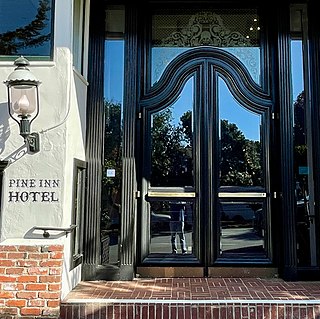
Pine Inn, once called the Hotel Carmelo, is one of the early first-class Arts and Crafts, Tudor, Spanish style hotels established in Carmel-by-the-Sea, California. The Pine Inn is a historical resource dating back to 1889 when pioneer Santiago J. Duckworth built Hotel Carmelo. James Franklin Devendorf, renamed the hotel the "Pine Inn" in 1904. Today, it is a full-service hotel. The Pine Inn qualified for inclusion in the city's Downtown Historic District Property Survey, and was registered with the California Register of Historical Resources on March 18, 2003. The Inn is significant under the California Register criterion 1, as the first hotel in the history of the downtown district of Carmel-by-the-Sea.

The Reardon Building also known as the Carmel Dairy Building is a Spanish Eclectic style two-story commercial building in downtown Carmel-by-the-Sea, California. It was designed by Guy O. Koepp and constructed by A. Caryle Stoney in 1932 for the Carmel Dairy, which sold milk products. It had a milk bottle-shaped tower. Artist Jo Mora did the interior artwork and logo on milk bottles and lunch menu. The building frames the entrance to downtown Carmel. It has been a retail shop since 2002.

The Kocher Building, also known as La Giralda is a two-story steel and concrete framed Spanish Eclectic style commercial building in Carmel-by-the-Sea, California. It was designated as an important commercial building in the city's Downtown Historic District Property Survey, on September 4, 2002.

The Carmel Weavers Studio, also known as Cottage of Sweets, is a historic Tudor-style English cottage in Carmel-by-the-Sea, California. It was designed by Edward G. Kuster and constructed by Lee Gottfried in 1922 for Kuster's wife as a weaving shop. Since 1959, it has operated a candy store.

The Seven Arts Shop, is a one-story, wood-frame Tudor Storybook retail shop in Carmel-by-the-Sea, California. During the 1930s, the building served as the reading room for the Christian Science organization. It has been designated as a significant commercial building in the city's Downtown Historic District Property Survey, and was recorded with the Department of Parks and Recreation on January 23, 2002.

The Seven Arts Building, is a one-and-one-half-story, Tudor Revival-style commercial building in downtown Carmel-by-the-Sea, California. It was designed by Albert B. Coats and built by Percy Parkes for poet mayor Herbert Heron in 1925, as a bookshop and printing press. It was built with Thermotite fireproof concrete blocks. It was home to the Carmelite newspaper, the Carmel Art Association's first gallery, and the Carmel Art Institute. Since 1972, it has been a retail store.

Sade's is a one-and-one-half-story, commercial building in downtown Carmel-by-the-Sea, California. It was built in 1925, for novelist and dramatist Harry Leon Wilson and his wife Helen MacGowan Cooke as a flower shop and dress shop. In the 1930s, Sade was a former Ziegfeld Follies dancer, made the lower level into a restaurant and bar. The City of Carmel has recognized the building as a historical resource in the area of architecture, as an important contributor to the design of the Court of the Golden Bough, and as a significant example of commercial Tudor Revival design by Lee Gottfried.

The Sundial Lodge is a Medieval Revival-style hotel in Carmel-by-the-Sea, California. It was designed by architect Albert L. Farr of San Francisco and was built in 1930, by Master builder Michael J. Murphy. The Sundial Lodge has been recognized by the city as a historical resource and was officially submitted to the Department of Parks and Recreation on December 5, 2002.
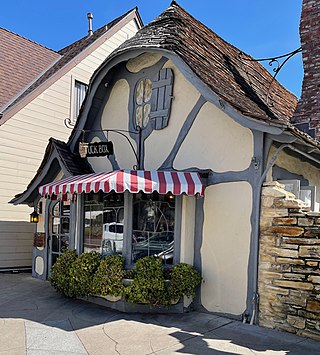
The Tuck Box is a historic Craftsman Storybook style commercial building in downtown Carmel-by-the-Sea, California, United States. It was built in 1926, by master builder Hugh W. Comstock. The building was designated as a significant commercial building in the city's Downtown Historic District Property Survey, and was recorded with the Department of Parks and Recreation on October 8, 2002.

The Mary Dummage Shop is a historic Craftsman Fairy tale commercial building in downtown Carmel-by-the-Sea, California. It was built in 1926, by builder Percy Parkes. The shop was designated as a significant commercial building in the city's Downtown Historic District Property Survey, and was recorded with the Department of Parks and Recreation on September 13, 2002.
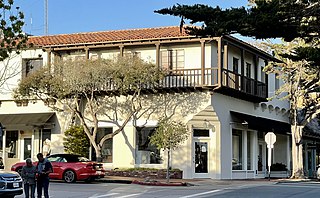
The Goold Building is a historic two-story concrete commercial building in downtown Carmel-by-the-Sea, California. The building is an example of Spanish Colonial Revival and Monterey Colonial styles. The building qualified as an important commercial building in the city's downtown historic district property survey and was registered with the California Register of Historical Resources on February 3, 2003. The building been used as a retail store since 1990s.
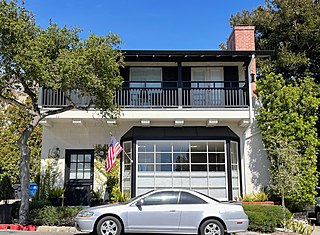
The Spinning Wheel Restaurant, is a historic commercial building in Carmel-by-the-Sea, California. It was built in 1952, by Monterey Peninsula Builders and designed by architect Edwin Lewis Snyder as a restaurant. It is an example of a Monterey Colonial architecture style building. The structure qualifies as an important building in the city's downtown historic district property survey and was recorded with the California Register of Historical Resources on June 5, 2006.

The Doud Building, also known as the James Doud Building is a historic commercial building in Carmel-by-the-Sea, California. James Cooper Doud established the building in 1932, built by master builder Michael J. Murphy as a mixed-use retail shop and residence. It is an example of a Spanish Colonial Revival architecture style building. The structure is recognized as an important commercial building in the city's Downtown Conservation District Historic Property Survey, and was nominated and submitted to the California Register of Historical Resources on February 21, 2003.

The Enchanted Oaks Building, is a historic commercial building, built in 1927, in Carmel-by-the-Sea, California, United States. The structure is recognized as an important commercial building in the city's Downtown Conservation District Historic Property Survey, and was nominated and submitted to the California Register of Historical Resources on January 29, 2003. The building is occupied by the Silvestri Vineyards.
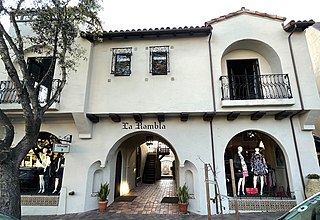
The La Rambla Building is a historic commercial building, built in 1929, in Carmel-by-the-Sea, California. The structure is recognized as an important Spanish Eclectic-style building in the city's Downtown Conservation District Historic Property Survey, and was nominated and submitted to the California Register of Historical Resources on January 30, 2003.
Percy Parkes was an American master builder in Carmel-by-the-Sea, California. Parkes was one of the main progressive builders in Monterey County through the 1920s and 1930s, and the first contractor to build homes on Scenic Drive. His best known commercial buildings are the Seven Arts Building (1928), the Dummage Building (1924), and the Percy Parkes Building (1926). His American Craftsman-style, influenced by the Arts and Crafts movement, is evident in the buildings he constructed during that time.

Robert R. Jones was an American architect in Carmel-by-the-Sea, California best known for his Modern architecture. Jones designed numerous residences and commercial buildings in the Monterey Peninsula. In the post-war period, he emerged as a prominent figure among architects and designers who played a pivotal role in shaping Carmel's modernist landscape from the middle 20th century onward. His was known for his design aesthetic that was a Modern architecture-style, combined with elements from the Second Bay Tradition. His creation, the Monterey Airport Administration building, was honored with a design award by the Smithsonian Institution.
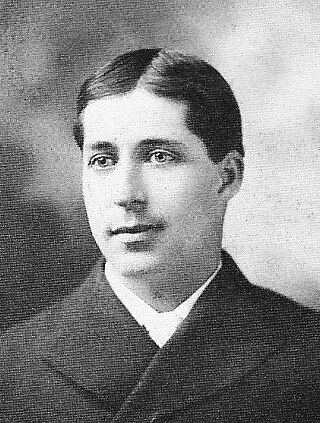
Fred Ruhl was an American master builder in Monterey County, California. He is best known for his contributions to the architecture of Pebble Beach, and Carmel-by-the-Sea, most notably for the Outlands in the Eighty Acres, listed on the National Register of Historic Places. He worked closely with architect Robert Stanton to build the Normandy Inn on Ocean Avenue in Carmel.























